
views
Short-Term Storage
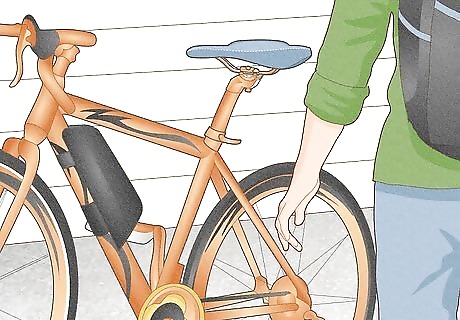
Keep the frame and battery together if you’re riding the bike soon. If you plan on riding your bike in the next day or so, it’s not that big of a deal if you store the frame and battery together. If you leave the battery in, your ebike may drain it slightly while it’s off, but if your battery isn’t low it shouldn’t have a huge impact. If you ride your bike regularly, you may need to take the battery out to charge it every 4 days or so.

Turn the power off once you’re done riding your bike. The power button on your ebike turns the computer on or off. Either press this button once or press the button and hold it down for 5 seconds to turn the computer off depending on your brand and model. Many electric bikes will shut off automatically after a few minutes if you aren’t actively pedaling.
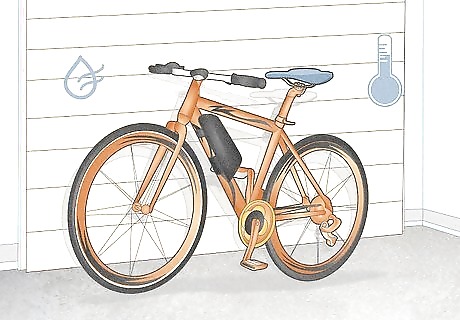
Store your bike indoors in a cool, dry place. Keep your ebike out of the elements and store it inside whenever you can. While your frame will be fine if it’s a little cold or hot, you don’t want the temperature to fluctuate too much to preserve the battery. Any room will work so long as it isn’t going to too hot over the course of the night and there is low humidity. You can leave your bike in a garage or shed overnight, but only if it’s cool out and it won’t get too hot during the day. Lithium batteries can be a fire risk, but every type of battery can short or lose its charge when it gets too hot. If you’re short on space, a vertical wall rack in your basement or living room will work just fine. Keep the bike away from excess humidity, since moisture can cause the bike’s electrical components to corrode. Store it away from any vents or windows where there might be a lot of condensation or humidity.
Long-Term Storage
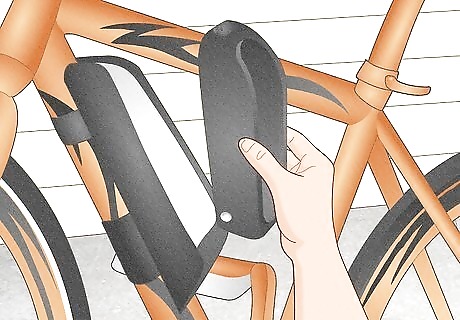
Take the battery out of the bike if you won't ride it in the next few days. If you know you aren’t going to ride your bike soon, take the battery out to store it separately. If you use a key to unlock your battery, insert it into the keyhole on the side of the frame and turn it counterclockwise to release the battery. If you use a switch or some other system to unlock your battery, follow the instructions in your user manual to remove the battery. Removing the battery will prevent corrosion buildup on the battery terminals when you aren’t riding it.
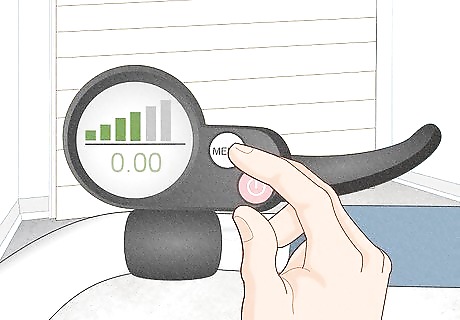
Leave the battery partially charged to prolong its lifespan. Check your bike’s instruction manual to find the recommended range for your battery when you’re storing it. Before you turn your bike off, check the battery level on your computer screen, gauge, or battery case. If it’s within the recommended range, you’re ready to store the battery. If it’s too low, charge your battery. If the charge is too high, ride it around the block a few times to drain the charge. This will prolong the lifespan of the battery and keep it stable while you aren’t riding for a while. It’s not the end of the world if you don’t get the battery under the recommended range if you’re going to ride it relatively soon. If you’re storing the bike for more than a month, you definitely want to ride it for a little before storing it, though.
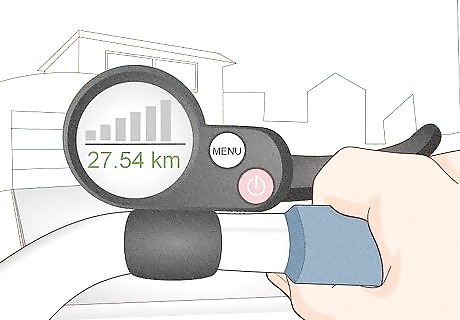
Discharge the battery entirely if the manufacturer recommends it. Some batteries need to be entirely discharged if you’re storing them for more than 1 month. Read your bike’s instruction manual to see if you need the battery to be partially charged or entirely drained before storing it for a long period of time.

Set the battery indoors in a dry area where it stays 32–68 °F (0–20 °C). Generally speaking, the warmer your battery gets, the worse it will perform. The battery can even catch fire if it gets way too hot, especially if you have a lithium battery. Choose a location in your home where the battery will stay cool and dry. A moisture-free basement is a great choice, but you could also store it near an air conditioner, vent, or fan to keep it cool so long as there isn’t a ton of humidity. If you have a lead-acid battery, the refrigerator is actually the most ideal place for it. These batteries perform a lot better when they’re kept cold, but not freezing. Never cover your battery and charger when you aren’t using them. If you put a rag over the battery, for instance, it may warm up a little and lose its charge. It could also be a fire hazard if your battery gets super hot.
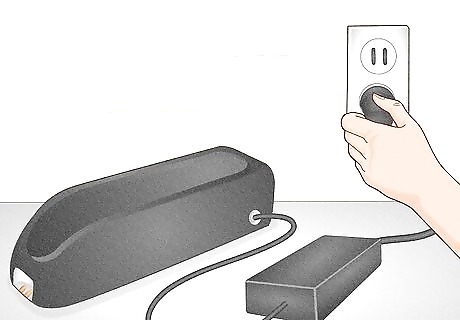
Plug in your battery on a concrete floor if it’s getting low. If your battery needs to be charged, set it on a concrete floor and plug it into the charger. Only use the charger that came with your bike to ensure the battery stays safe while it charges. Continue charging your battery until it’s over 30%. If you’re going on a long ride in the near future, let it reach the recommended charge before taking it off of the charger. While your battery is unlikely to catch fire, it’s best to charge it on concrete surface just to be safe. Do not leave your battery unattended while it charges. You don’t need to charge the battery after every ride. A full battery will typically last 20–40 miles (32–64 km), so you may only need to charge it once a month depending on how often and how far you ride your bike. Never overcharge your battery. If you do charge it up to 100% for a long bike ride, unplug the charger as soon as your battery is topped off. Over-charging an ebike battery will drain the lifespan.
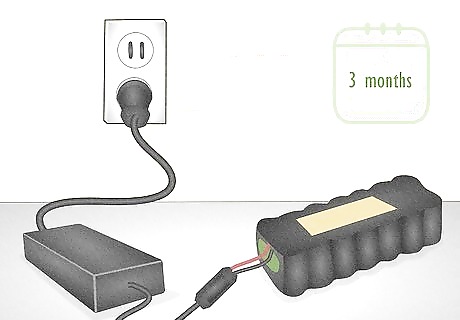
Charge lead-acid and NIMH batteries a charge at least once every 3 months. If you have a lead-acid or nickel-metal hydride (NIMH) battery and you aren’t riding your bike anytime soon, plug it into the charger once every month or two while you aren’t using the bike. These batteries tend to discharge quickly when they aren’t being used, so recharge them periodically to prolong the battery’s lifespan. Just as a reminder, you can store lead-acid batteries in the refrigerator to keep them cool. NIMH batteries aren’t especially common today, but they’re pretty similar to lead-acid. They tend to last a little longer than lead-acid, but you can’t store them in the fridge. Lead-acid batteries are generally considered the weakest option when it comes to long-lasting and consistent ebike performance. If you’re ever in the market for a new ebike, try to avoid lead-acid batteries.
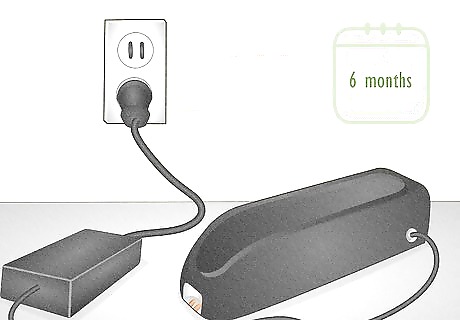
Give lithium batteries a charge at least once every 6 months. Lithium batteries last a lot longer than lead-acid or NIMH batteries. However, they still need to be charged if you aren’t riding the bike anytime soon. Once every 6 months or so, plug your battery into the charger for a few hours before putting it back into storage. Lithium batteries can be a fire risk if they get too hot, so do your best to keep these batteries cool. Never charge these batteries in an area where you can’t supervise them. If you can, keep them in a fireproof bag in a cool room.
Space-Saving Storage Ideas

Use a wall rack to store your ebike inside if you ride it regularly. Wall racks are a great option for e-bikes since you can keep your ebike inside without taking up floor space. Use a stud finder to locate studs in the wall for your rack and drill holes into the wall to install your anchors. Then, install the base of the rack into the wall and hang your hooks on the base. Let your bike hang on top of the hooks to store it on your wall. The other upside here is that you can install the rack near your door so that you can grab the ebike right before you leave and hang it up as soon as you get home.
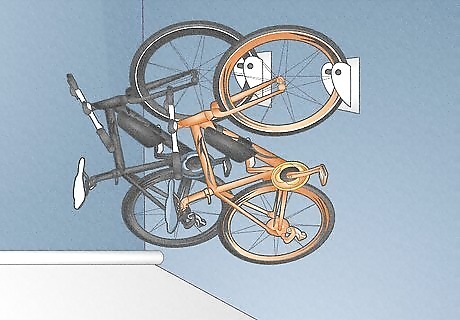
Install a multi-hook system to hang multiple bikes in a tight space. Multi-hook systems let you hang multiple bikes in one location on your wall. This is a great option if you own several ebikes or you have a regular bike in addition to your ebike. Each multi-hook system is installed differently, but you typically drill a steel bar into a section of studs and then hang hooks on the bar’s railing. Then, you clip the front tires to the hooks and let your bikes hang vertically. You can use any spare hooks to hang a spare tire, coat, or messenger bag.
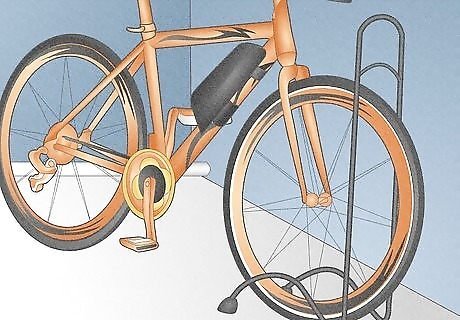
Go for a freestanding rack if you want to avoid drilling into the walls. Freestanding racks are a great option if you live in an apartment and you don’t want to risk that security deposit. Look online or go to a bike shop and purchase a freestanding rack. Follow the manufacturer’s instructions to assemble the rack and set it down in a convenient corner of your home. Hang your bike on the rack to keep it out of the way. Some freestanding racks have 2 sets of hooks to hang 2 bikes together.
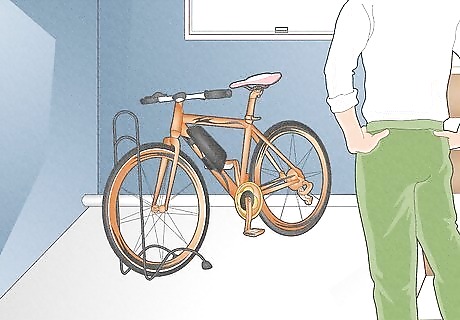
Keep the ebike in a basement or bike room to keep it out of sight. If you have a basement or a storage unit in your apartment building, this can be the easiest option. Just set your ebike on its kickstand or lean it against the wall. If there’s a bike rack, lock it to the rack. Just keep in mind that you shouldn’t leave the battery in the bike if you’re going to store it in a basement or storage unit if you aren’t riding it soon. Ebikes need to stay dry and cool. If your basement is especially humid or it tends to get hot in the summer, this isn’t a safe location for your investment. Some apartment buildings have a dedicated bike room. If you live in a large apartment building, ask your landlord if they have a good spot for your bike.


















Comments
0 comment